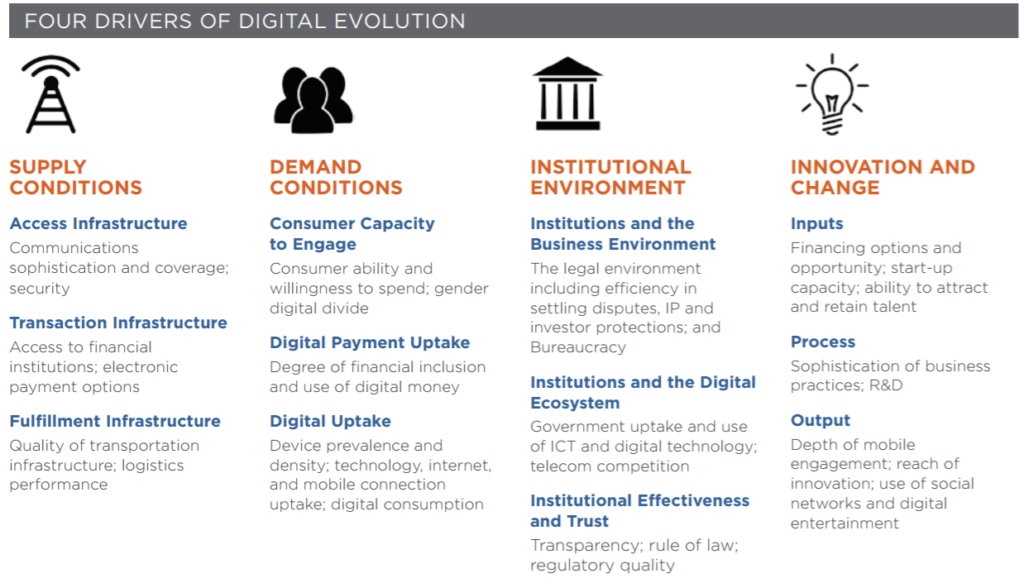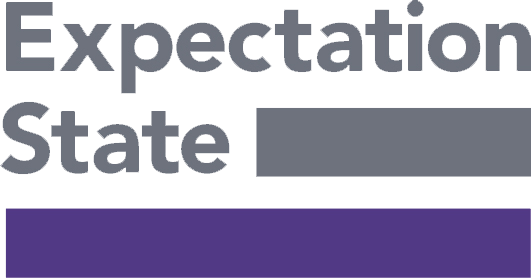What makes a Digital Nation?


The idea of what makes a digital nation has been pretty well documented over the last 10 years, summed up nicely in the graphic below, published by the Digital Planet initiative in 2017. For developed digital markets and nations, this will be a little old hat. These components are part of a thriving digital ecosystem, which work to reinforce each other and promote advances in each area, driven by both the private and public sector.

Take the UK, where in the early part of the last decade: the Government Digital Service was established to disruptively drive digital transformation and Government services; Tech City was formed as an agency to promote and support ecosystem building; 4G was introduced to the market; and tech investment through a combination of incubators, funds and multinational investment grew the digital economy at the rate of data down a fibre optic cable. Today, those components have evolved and grown to represent an undeniable digital nation. The question I am commonly asked in the markets where we work is: how do we grow our Digital Nation?
For more developing markets, these components and corresponding vision for a digital nation are scary and balkanised across the ecosystem. A start up success story here, a Government innovation agency there, a desire to put more government services online, support from donors – it’s a familiar picture. How can individual digital initiatives be transformed into an all-singing, all-dancing Digital Nation?
In my experience, one of the main issues is providing the confidence and tools for the public and private sector to grow the ecosystem collaboratively, offering advice on the “how”. This usually means the public sector listening and creating space for the private sector and digital economy to thrive. Again, easier said than done.
Faced with this challenge, I have been looking at the Digital Nations group for inspiration. As per their website: Founded in 2014, our collective goal is to harness the potential global power of digital technology and help one another to become even better digital governments, faster and more efficiently through sharing and learning from each other. Each participant agrees to lead by example and contribute with its expertise on a non-binding, voluntary basis. The participants are connected by the principles of user needs, open standards, open source, open markets, open government, connectivity, teaching children to code, assisted digital and a commitment to share and learn.
Sounds great doesn’t it? Having spoken to a couple of representatives from participant nations, I have drawn the conclusion that the strength of this group is the trust, sharing and informality that has been created to support “doing”. Yes, there is a formal quite classic multilateral structure with Ministers and senior officials, but that serves as top-cover for the informal communication and sharing across those in each member government charged with making things happen. This is essentially the application of a tech business model and environment to Government delivery and innovation.
So, can this work in, let’s call them: Emerging Digital States? In my humble, far from expert opinion, here’s what we might need to build a similar group for far less digitally developed states.
- The Digital Nations grouping works because there is a clear offer: an informal network of public sector technologists who are willing to share their experiences, approaches, problems and solutions with other public sector technologists to provide faster, more meaningful technology based solutions for their respective governments and citizens. The offer is based on these people existing in government administrations: people with a high degree of tech expertise, who naturally see the value in working through sharing. With no offer, there can be no grouping. In Emerging State Government institutions, these people do not exist, either in numbers, or sometimes at all. If they do, it is unlikely they will have the time or headspace to see the value of a group promoting sharing and learning. As a result, any support to a grouping of Emerging Digital States will have to build capability to generate the offer with the end result of the group in mind rather than having the group as the starting point. Without doing this, it will not work.
- Less developed digital nations lack the institutions and people charged with digital transformation. This was the case in the Digital Nations grouping 10 years ago. Traditional administrative structures are not open to innovation and disruption; they want rules and structure. Just because digital transformation and technology is increasingly embedded and mainstreamed in the more traditional and formal structures of developed governments, it doesn’t mean it was always that way. It wasn’t. We have to remember this in Emerging States. It is highly unlikely that the right “offer” exists in the Digital / Technology Ministry at any level of scale. Rather we will find generalists and bureaucrats. As a result, we need to be more creative about where the offer is developed, spending time and effort to identify individuals and institutions that demonstrate a more natural ability to work in a more open, sharing way without going for the obvious or assuming the solution can be found in the Ministry or institution with Digital in the title.
- There is benefit to a multilateral make-up. It is important to have a top-down structure in place to provide a frame but we cannot fall into the trap of setting up another traditional multilateral grouping where it becomes a senior level talking shop with the result being: Ministers met and discussed digital transformation. The top down and bottom up need some level of coordination – a secretariat. For the informal element, the secretariat needs to be light touch, connecting and navigating member states to build the necessary trust and sharing for the offer to be valued. For the more formal meetings, the secretariat needs to feed CTOs and Ministers with the necessary background and briefing to ensure that political will for the grouping is strengthened over time. In Emerging States the political landscape will almost always be a consideration; we need secretariats that understand both political context and the technical solutions that can be applied.
These are just initial thoughts and observations, based on experience supporting a handful of countries in the Middle East and North Africa in this space. I’m told all decent articles need a call to action. So here are mine:
- Tell me whether there is value in creating a group of Emerging Digital States as a means to catalyse digital transformation in countries like Jordan, Tunisia, Morocco and Lebanon.
- If you see value, tell me how you can help
- If you don’t see value, tell me what another solution might be
Expectation State takes a different approach to development in emerging states. Recently we have supported the design of a national digital agency, are studying the feasibility of a blockchain enabled digital compartment for a stock exchange, and are researching the tensions between investment in digital technology and the impact on individual rights.


.svg)
